
Pallas is the second asteroid to have been discovered, after Ceres. Like Ceres, it is believed to have a mineral composition similar to carbonaceous chondrite meteorites, though significantly less hydrated than Ceres. It is the third-largest asteroid in the Solar System by both volume and mass, and is a likely remnant protoplanet. It is 79% the mass of Vesta and 22% the mass of Ceres, constituting an estimated 7% of the mass of the asteroid belt. Its estimated volume is equivalent to a sphere 507 to 515 kilometers in diameter, 90–95% the volume of Vesta.
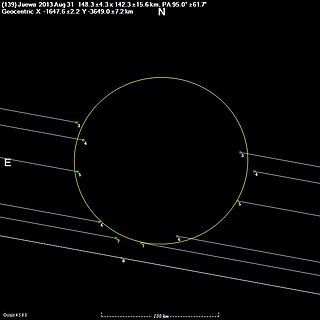
139 Juewa is a very large and dark main belt asteroid. It is probably composed of primitive carbonaceous material. It was the first asteroid discovered from China.
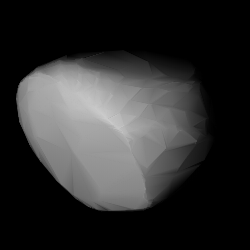
1036 Ganymed, provisional designation 1924 TD, is a stony asteroid on a highly eccentric orbit, classified as a near-Earth object of the Amor group. It was discovered by German astronomer Walter Baade at the Bergedorf Observatory in Hamburg on 23 October 1924, and named after Ganymede from Greek mythology. With a diameter of approximately 35 kilometers, Ganymed is the largest of all near-Earth objects but does not cross Earth's orbit. The S-type asteroid has a rotation period of 10.3 hours. In October 2024, it is predicted to approach Earth at a distance of 56,000,000 km; 35,000,000 mi (0.374097 AU).
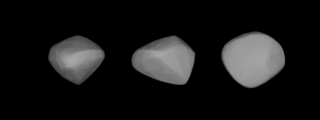
Phocaea is a stony asteroid from the inner regions of the asteroid belt, approximately 75 kilometers in diameter. It is the parent body of the Phocaea family. Discovered by Jean Chacornac in 1853, it was named after the ancient Greek city of Phocaea.

Leda is a large, dark main-belt asteroid that was discovered by French astronomer J. Chacornac on January 12, 1856, and named after Leda, the mother of Helen of Troy in Greek mythology. In the Tholen classification system, it is categorized as a carbonaceous C-type asteroid, while the Bus asteroid taxonomy system lists it as a Cgh asteroid. The spectra of the asteroid displays evidence of aqueous alteration.

Harmonia is a large main-belt asteroid. It was discovered by German-French astronomer Hermann Goldschmidt on March 31, 1856, and named after Harmonia, the Greek goddess of harmony. The name was chosen to mark the end of the Crimean War.
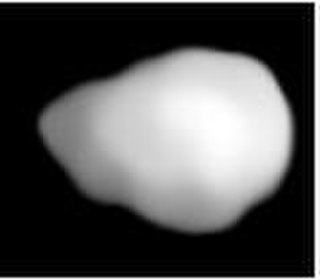
Daphne is a large asteroid from the asteroid belt. It is a dark-surfaced body 174 km in diameter is probably composed of primitive carbonaceous chondrites. The spectra of the asteroid displays evidence of aqueous alteration. It was discovered by H. Goldschmidt on May 22, 1856, and named after Daphne, the nymph in Greek mythology who was turned into a laurel tree. Incorrect orbital calculations initially resulted in 56 Melete being mistaken for a second sighting of Daphne. Daphne was not sighted again until August 31, 1862.

Felicitas is a dark and fairly large main-belt asteroid. It was discovered by German-American astronomer C. H. F. Peters on October 9, 1869, and named after Felicitas, the Roman goddess of success. The only observed stellar occultation by Felicitas is one from Japan.

Ate is a main-belt asteroid discovered by the German-American astronomer C. H. F. Peters on August 14, 1870, and named after Ate, the goddess of mischief and destruction in Greek mythology. In the Tholen classification system, it is categorized as a carbonaceous C-type asteroid, while the Bus asteroid taxonomy system lists it as an Ch asteroid.

Kassandra is a large and dark main-belt asteroid. It belongs to the rare class T. It was discovered by C. H. F. Peters on July 23, 1871, and is named after Cassandra, the prophetess in the tales of the Trojan War. The asteroid is featured in the 2009 film Meteor, in which it is split in two by a comet, and set on a collision course with Earth.

Johanna is a large, dark main-belt asteroid that was discovered by French astronomers Paul Henry and Prosper Henry on 5 November 1872, and is believed to be named after Joan of Arc. It is classified as a CX-type asteroid, indicating the spectrum shows properties of both a carbonaceous C-type asteroid and a metallic X-type asteroid.

137 Meliboea is a large, dark main-belt asteroid that was discovered by Austrian astronomer J. Palisa at the Austrian Naval Observatory on 21 April 1874, the second of his many asteroid discoveries. It was later named after Meliboea, the daughter of Oceanus and Tethys in Greek mythology. The largest body in the Meliboea family of asteroids that share similar orbital elements, only 791 Ani approaches its size. It is classified as a C-type asteroid and may be composed of carbonaceous materials. The spectra of the asteroid displays evidence of aqueous alteration.

144 Vibilia is a carbonaceous asteroid from the central region of the asteroid belt, approximately 140 kilometers in diameter. It was discovered on 3 June 1875, by German–American astronomer Christian Peters at Litchfield Observatory of the Hamilton College in Clinton, New York, United States. Peters named it after Vibilia, the Roman goddess of traveling, because he had recently returned from a journey across the world to observe the transit of Venus. Peters also discovered 145 Adeona on the same night. The official naming citation was published by Paul Herget in The Names of the Minor Planets in 1955.
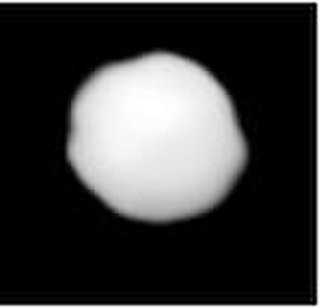
Adeona is a large asteroid from the intermediate asteroid belt, approximately 150 kilometers in diameter. Its surface is very dark, and, based upon its classification as a C-type asteroid, is probably composed of primitive carbonaceous material. The spectra of the asteroid displays evidence of aqueous alteration. The Adeona family of asteroids is named after it.

Prokne is a main-belt asteroid that was discovered by German-American astronomer C. H. F. Peters on March 21, 1879, in Clinton, New York, and named after Procne, the sister of Philomela in Greek mythology. Stellar occultations by Prokne have been observed twice, in 1984 from Italy and again in 1999 from Iowa.
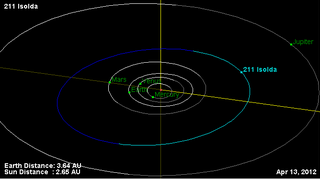
Isolda is a very large, dark main-belt asteroid. It is classified as a C-type asteroid and is probably composed of primitive carbonaceous material. The spectra of the asteroid displays evidence of aqueous alteration.
Hamburga is a carbonaceous asteroid from the background population of the intermediate asteroid belt, approximately 75 kilometers in diameter. It was discovered by German astronomers Max Wolf and Friedrich Schwassmann at Heidelberg Observatory on 31 October 1899, and later named after the city of Hamburg in Germany.
659 Nestor is a dark Jupiter trojan from the Greek camp, approximately 110 kilometers in diameter. It was discovered on 23 March 1908, by German astronomer Max Wolf at Heidelberg Observatory in southern Germany, and named after King Nestor from Greek mythology. The carbonaceous Jovian asteroid belongs to the 20 largest Jupiter trojans and has a rotation period of 15.98 hours.
783 Nora is a dark background asteroid from the inner regions of the asteroid belt. It was discovered by Austrian astronomer Johann Palisa at the Vienna Observatory on 18 March 1914. The carbonaceous C-type asteroid has a longer-than average rotation period of 55.5 hours and measures approximately 40 kilometers in diameter. It was likely named after Nora Helmer, principal character in the play A Doll's House by Norwegian poet Henrik Ibsen.
1028 Lydina, provisional designation 1923 PG, is a carbonaceous background asteroid and member of the Cybele group from the outermost regions of the asteroid belt, approximately 82 kilometers in diameter. It was discovered at the Simeiz Observatory on the Crimean peninsula on 6 November 1923, by Soviet astronomer Vladimir Albitsky, who named it after his wife, Lydia Il'inichna Albitskaya. The dark C-type asteroid has a rotation period of 11.68 hours.
















